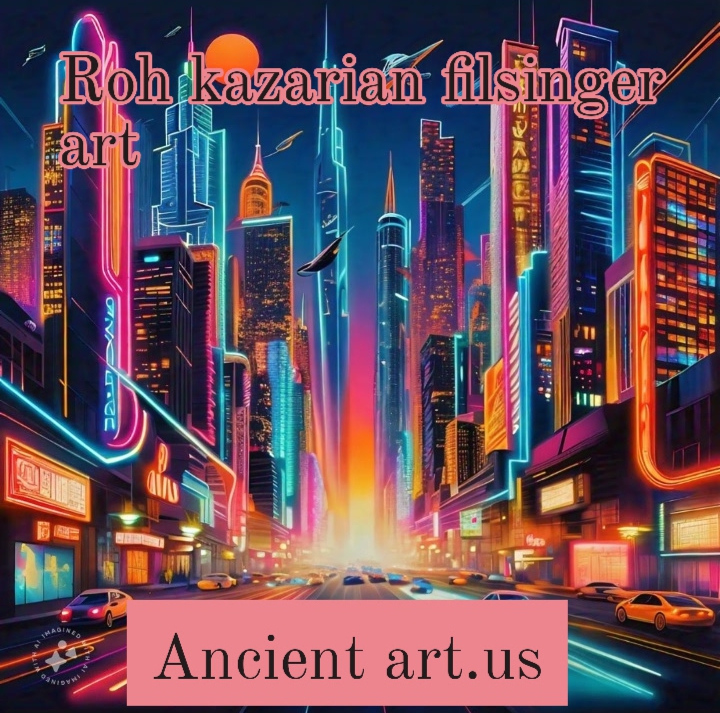Introduction
The world of contemporary art is vast, diverse, and constantly evolving. Amid this dynamic landscape, few artists stand out for their ability to bridge the gap between traditional techniques and modern innovation. Among these, Roh Kazarian and Filsinger are two names that have garnered significant attention for their unique contributions to the art world. Both artists, though working in distinct styles and mediums, share a common passion for pushing boundaries, exploring new technologies, and deepening our understanding of the human experience through art.
Roh Kazarian’s art is known for its intricate exploration of classical themes, masterful technique, and emotional depth. On the other hand, Filsinger is celebrated for his innovative use of digital technology, creating art that not only exists in the physical world but extends into the digital realm, offering new dimensions of interaction and engagement. Together, Kazarian and Filsinger represent the convergence of the old and the new, the tactile and the virtual, illustrating how art can evolve and adapt to the changing times while retaining its core ability to provoke thought and stir emotions.
In this article, we will explore the artistic journeys of Roh Kazarian and Filsinger, dive into their distinct styles, and examine the intersection of traditional and contemporary techniques in their works. We will also discuss their impact on the art world and consider how their work is shaping the future of art in both physical and digital spaces.
Roh Kazarian Art: A Mastery of Tradition and Emotion
Early Life and Artistic Roots
Roh Kazarian’s journey as an artist began in the heart of traditional fine arts. Raised in an environment where classical techniques were revered, Kazarian developed a profound appreciation for the works of the old masters. From a young age, he was captivated by the grandeur of Renaissance and Baroque art, drawing inspiration from the likes of Leonardo da Vinci, Michelangelo, and Caravaggio. His early studies in painting and sculpture laid the groundwork for a career that would fuse classical artistry with modern perspectives.
Kazarian’s formal education took him to some of the most prestigious art academies, where he honed his skills in traditional techniques. His expertise in oil painting, marble sculpture, and chiaroscuro allowed him to express deep, often spiritual themes through his work. However, despite his classical roots, Kazarian has always been driven to evolve and experiment, using his foundation as a springboard for creating art that speaks to both the past and the present.
Artistic Style and Themes
Kazarian’s artwork is known for its emotional intensity and meticulous attention to detail. His paintings often depict human figures in dramatic, heightened states of emotion, exploring the complexities of the human condition. Using a rich color palette and careful attention to light and shadow, Kazarian’s work creates a sense of depth and realism that allows viewers to engage with the characters on an emotional level.
A prominent feature of Kazarian’s art is his use of symbolism. Drawing on mythological, religious, and natural motifs, Kazarian weaves layers of meaning into his work. For example, the inclusion of animals, such as birds or lions, often represents freedom, strength, or spiritual transcendence. Light and dark are recurring motifs, used to illustrate moral and emotional contrasts, further emphasizing the internal struggles faced by his subjects.
Kazarian’s mastery of texture is another defining aspect of his work. Whether through the smooth surfaces of his paintings or the tactile qualities of his sculptures, Kazarian’s ability to manipulate materials gives his work a three-dimensional quality that invites tactile exploration, making the artwork feel alive and engaging.
Innovative Blends of Classic and Contemporary
Though deeply rooted in tradition, Kazarian never shies away from incorporating modern elements into his work. In recent years, he has experimented with mixed media, combining traditional materials like oil paint with digital techniques such as video projections and interactive installations. This innovative blend of classic and contemporary allows Kazarian to create art that is both timeless and timely, resonating with today’s audiences while maintaining a connection to the past.
Filsinger Art: A Digital Revolution in Creativity
The Rise of a Digital Artist
While Kazarian’s art thrives in the tactile world of traditional painting and sculpture, Filsinger’s work represents the cutting-edge possibilities of digital technology. Filsinger’s artistic journey began in the world of digital design, where he first explored graphic art, animation, and 3D modeling. Fascinated by the potential of technology to transform artistic expression, Filsinger soon transitioned into digital sculpture and virtual art, using software like Blender and Cinema 4D to create intricate, lifelike 3D models and immersive environments.
Filsinger’s work challenges the very definition of art, blurring the lines between the physical and the virtual. His ability to create works that exist only in digital spaces introduces a new dimension of interaction between art and viewer. The audience is no longer a passive observer but an active participant in the experience, able to manipulate, explore, and even influence the artwork in real-time.
Artistic Approach and Technique
Filsinger’s technique is rooted in the manipulation of light, shadow, and texture, much like Kazarian’s, but in the digital realm. His digital sculptures are meticulously crafted, often appearing as lifelike as traditional sculptures. However, they possess the added dimension of interactivity, offering the viewer the opportunity to engage with the art in ways that are impossible in the traditional art world.
A central theme in Filsinger’s work is the exploration of identity in the digital age. Through digital avatars and virtual environments, Filsinger examines how technology alters our perceptions of self, memory, and reality. His digital works often contain elements of surrealism, with glitch effects, distorted figures, and fragmented forms representing the fragmented nature of digital identity in a rapidly changing world.
Filsinger’s digital art also explores themes of transformation and evolution, using the capabilities of digital media to create works that constantly shift and evolve. Unlike static traditional art, Filsinger’s pieces are living, breathing entities that change based on the viewer’s interaction, making each experience unique.
The Future of Digital Art
As digital technologies continue to evolve, so too does Filsinger’s approach to art. With the rise of augmented reality (AR) and virtual reality (VR), Filsinger is at the forefront of exploring new ways to immerse viewers in his digital creations. These technologies allow for a level of engagement that traditional art simply cannot offer, creating fully interactive and immersive experiences that push the boundaries of what we consider art.
Kazarian and Filsinger: Bridging the Gap Between Tradition and Innovation
Common Ground: Themes of Human Experience
While Kazarian and Filsinger work in different mediums and styles, both share a deep commitment to exploring the human experience. Kazarian’s emotive portraits and symbolic sculptures delve into the complexities of human nature, while Filsinger’s digital avatars and immersive environments examine the ways technology is reshaping our understanding of self, identity, and memory.
Both artists are interested in identity—Kazarian through the exploration of the human figure and emotion, and Filsinger through the virtual selves we create online. Both artists also engage with themes of transformation, with Kazarian’s symbolic use of light and shadow representing the evolution of the soul, while Filsinger’s digital works suggest that our digital identities are fluid, ever-changing, and fragmented.
Traditional Techniques Meet Digital Media
What makes the works of Kazarian and Filsinger so fascinating is how they each approach similar themes from entirely different perspectives. Kazarian’s work relies heavily on traditional materials and techniques, creating tactile, emotional experiences that connect deeply with the viewer. Filsinger, however, explores these themes through a digital lens, using interactive technology to invite the viewer into a new form of artistic experience.
Both approaches highlight the potential for art to transcend its traditional boundaries. Kazarian’s recent experiments with digital projections in his sculptures and paintings, for instance, suggest that the future of art may lie in the merging of traditional techniques with new media. Filsinger’s work, with its constantly evolving digital environments, shows that the future of art may involve creating entirely new realities in which the viewer’s participation is a key element.
The Influence of Kazarian and Filsinger on the Contemporary Art Scene
Pioneers of Change
Kazarian and Filsinger are not just creating art—they are shaping the future of art. Kazarian’s seamless blend of classical and contemporary techniques serves as a reminder that traditional art forms still have relevance in today’s world. His work challenges the notion that modern art must always be abstract or digital, reminding us of the power of realism, symbolism, and emotion in art.
Filsinger, on the other hand, is pushing the boundaries of what art can be in the digital age. His use of virtual reality and interactive digital art is paving the way for a new generation of artists who view art not as a static object but as a dynamic, participatory experience. His work is helping to redefine the role of the artist and the viewer, transforming art into a conversation rather than a monologue.
Both Kazarian and Filsinger are redefining the concept of artistic expression, encouraging us to think differently about the role of technology in art and how it can shape the future of creativity.
Conclusion
Roh Kazarian and Filsinger are two visionary artists whose work reflects the shifting paradigms of contemporary art. Kazarian, with his classical roots and mastery of traditional media, brings timeless emotional depth and symbolism to the modern art world. Filsinger, on the other hand, represents the future of art, embracing technology and digital media to create interactive, immersive works that challenge our perceptions of reality.
Together, Kazarian and Filsinger demonstrate that the boundaries between traditional and contemporary art are not fixed but fluid, with each artist showing us a new way to engage with the world around us. As they continue to push the limits of creativity, their work will undoubtedly influence the next generation of artists, encouraging them to explore the endless possibilities of both the physical and digital realms.
FAQs About Kazarian and Filsinger Art
1. What is the primary difference between Kazarian and Filsinger’s art?
Kazarian works with traditional media such as painting and sculpture, focusing on emotional expression, symbolism, and classical techniques. Filsinger, however, creates digital art, using technology like 3D modeling and virtual reality to craft interactive and immersive experiences.
2. What themes are commonly explored in their works?
Both artists explore themes of identity, transformation, and the human experience. Kazarian delves into the emotional and symbolic aspects of the human condition, while Filsinger examines how technology influences our understanding of self and reality.
3. How does Filsinger’s use of technology change the art experience?
Filsinger’s use of digital tools allows for a more interactive experience, where viewers can engage with the artwork in real-time, altering their perceptions of the art and creating a personalized experience.
4. Are there any similarities in their artistic visions?
Yes, both artists are interested in the intersection of tradition and innovation. Kazarian integrates modern elements into his classical works, while Filsinger embraces new media to explore timeless themes in innovative ways.
5. What impact have Kazarian and Filsinger had on contemporary art?
Kazarian’s work has helped reaffirm the relevance of traditional art in the modern world, while Filsinger is at the forefront of digital art, showing how technology can reshape the artistic landscape. Both are pioneers in their respective fields, influencing the future direction of art.


